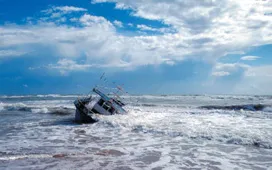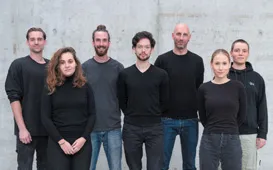Tomorrowland
Change
In 1978 the science fiction writer Isaac Asimov published an essay entitled ‘My own View’, within which he stated:
It is change, continuing change, inevitable change, that is the dominant factor in society today. No sensible decision can be made any longer without taking into account not only the world as it is, but the world as it will be. […] This in turn means that our statesmen, our businessmen, our everyman, must take on a sciencefictional way of thinking._1
This kind of change, which Asimov already described some forty years ago becomes ever more obvious today. We live in a time where technology is multiplying around us at an ever increasing pace. If we are to believe the Director of Engineering at Google Ray Kurzweil, who has analyzed the growth rate of various technological systems, then by 2045 this development will lead to a certain state of Singularity, a point where progress will be so fast that it exceeds our ability to comprehend it implying an infinite rate of change happening momentarily._2 Once this moment has been surpassed mankind will reach a state of transhumanism, where humans will merge with intelligent machines and through this surmount the biological restraints of its physical and psychological constitution.
Android, Koshinuke, 2019
A similar kind of growth can also be observed demographically. Since the 1960s the world population has more than doubled, growing from 3 to about 7.5 billion today, and according to a recent UN study is expected to rise to roughly 10 billion by 2050;_3 and 70% of all those people are going to be living in large megacities._4
At the same time the average global life expectancy has in the last 100 years increased from 46 years of age in 1910 to 70 in 2014 and is supposed to exceed 76 by mid century._5
By 2050 we will also need 80% more energy than today,_6 consume up to 90% more food,_7 have more trash in the ocean than fish,_8 almost every vehicle on the planet will be autonomous and self-driving, there will be 200 million worldwide climate refugees,_9 and apparently human-robot or human-computer relationships could have become common. Obviously, such tendencies not only have an impact on ourselves and our behavior as a species but also on our planet’s ecological system, its biodiversity, climate and atmosphere. An impact that is actually so severe and irreversible that scientists have proposed to constitute a new geological epoch: the Anthropocene - the age of humans.
Mexico City, Eneas De Troya, 2016
Shipwreck, Gerhard Lipold, 2012
The Anthropocene is a period, beginning in the 1950s with atomic bomb testing, throughout which the face of earth has been largely defined by human activity. However the Anthropocene is not only a time of man-made disruption, it is also - at least more recently - a moment of awakening, of blinking self-awareness in which we are becoming conscious of ourselves as a planetary force. We’re not only driving global warming and ecological destruction, we know that we are.
Ironically, it is only by despoiling the planet that we have understood just how much a part of it we are. But what to do when everything one does becomes an environmental question? When every time we start the engine of our car, every time we pick up a plastic bag in the supermarket, every time we eat a burger at McDonald’s, we change the world?
Times Square, Roberto Lee Cortes, 2019
This shared impact, resulting from a multitude of minor yet largely unsustainable behaviors as a global species, means that if we keep going like this the human race will require almost a second planet, or to put it differently will have used up all the world’s annual resources by mid-August._10
Adapt
So, the question we should be asking is not whether climate change or any other of these “things” are real, nor when they will happen, since it doesn’t really make a difference if it’s in five or ten or fifty years. The question would be “What is the most human and sustainable way to adapt?” or as Norbert Wiener put it in 1954:
We are the slaves of our technical improvement and we can no more return a New Hampshire farm to the self-contained state in which it was maintained in 1800. [...] We have modified our environment so radically that we must now modify ourselves in order to exist in this new environment. We can no longer live in the old one._11
Unfortunately when facing unprecedented challenges, oftentimes we tend to do the exact opposite to Wiener’s suggestion. Instead of adapting, changing, evolving and trying to understand the cause and reason of these events, we block their symptoms through a viscous fight for preservation. We build walls against rising sea levels, walls to keep those in need away from those who have, walls as the encapsulating response to a growingly globalized world.
Glacier, Joshua Woroniecki, 2014
Hydrophobic Droplets, Adrian Malec, 2017
Maybe it is time to reconsider our attitude; maybe it is time to stop fighting change, stop mourning after the good old days and instead embracing it as something from which the new can emerge. And in that context, of transformation and mutation, paired with a good portion of naivité and curiosity at what the future might behold, may create environments and experiences that can adapt, grow, evolve and include rather than exclude.
Returning to the acceleration in technological progress there lies amazing potential in developing solutions based on adaptive materials, solutions which have not only one single state or purpose but which behave multidimensionally. Such materials can change their shape, change their color, produce light or electricity, store heat or water, or even adjust their surface texture. However, despite a growing interest in the performative aspects of this kind of materiality most design scenarios are still rather traditional and fall far from exhibiting any of the radical opportunities that these materials offer, which is due to a number of reasons:
Firstly, many new materials are still technologically immature and often not developed with respect to design or architectural applications. Even when they are available as finished products, they have rather narrow properties since they are always designed for a very specific purpose limiting their scalability and durability.
Secondly, there is a big gap between the artistic disciplines and scientific research. The amount of information on new material developments that is comprehensible without having expert knowledge or insights is very limited and often scientifically mystified.
And lastly - and this is something that we as designers have to address - there is a lack in ideologically distinguishing smart materials from traditional ones. The defining dynamic properties are either constrained by forcing them onto existing structures and systems, or even neglected by standardizing and categorizing them to make them comparable to non-active materials and include them in existing databases and catalogues.
In an attempt to overcome these issues materiability was initiated in 2012 - an online platform, an educational framework and open materials database that provides in-depth access to emerging material developments. From this endeavor the Materiability Research Group with associated Materiability Research Lab (page 60) was founded in Dessau at the Anhalt University of Applied Sciences in 2019, right next to the historical Bauhaus building by Walter Gropius. The group’s work focuses on exploring novel material fabrication in unison with digital design and fabrication processes. A particular emphasis is on adaptive or smart technologies as well as biological materials and their impact on our future environment.
Materiability Team 2021, Sebastian Steffes, Paulina Schröder, HS Anhalt, 2021
Play
The core idea behind this approach, with a strong focus on playful experimentation and intuition, is based on a philosophy of design by making, which understands design as a dynamic process and not as the result of a predetermined idea. Or as Kurt Schwitters described it in 1924:
Every form is the frozen instantaneous picture of a process. Thus a work is a stopping-place on the road of becoming and not the fixed goal. We acknowledge works which contain a system within themselves, a system which has not been evolved before the work started but has evolved in the course of it._12
This concept is mediated through explorative and playful workshops and courses, where the participants are encouraged to physically experience the functionality of materials, comprehend their working principles and composition and understand the relationship...







